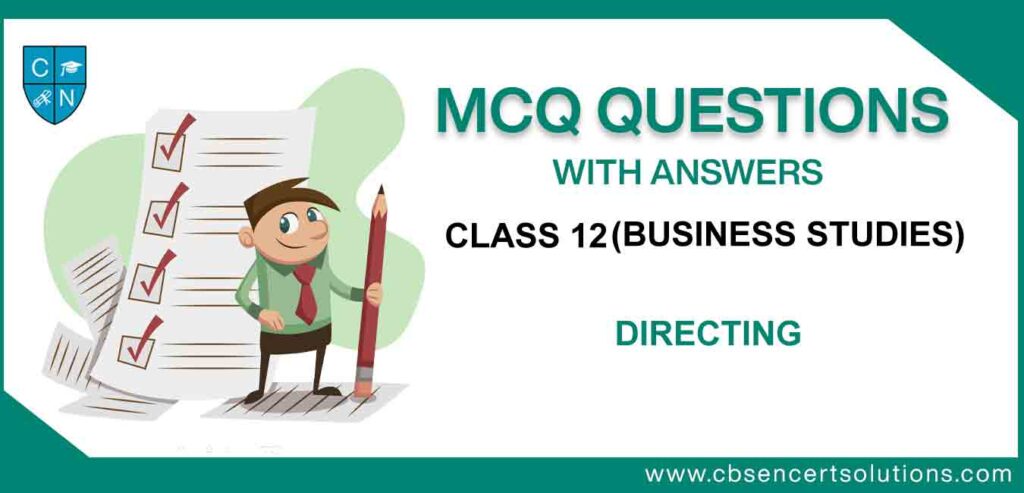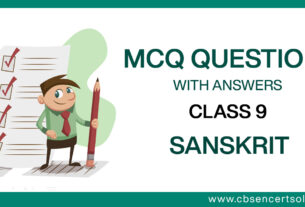Check the below NCERT MCQ Class 12 Business Studies Chapter 7 Directing with Answers available with PDF free download. MCQ Questions for Class 12 Business Studies with Answers were prepared based on the latest syllabus and examination pattern issued by CBSE, NCERT and KVS. Our teachers have provided below Directing Class 12 Business Studies MCQs Questions with answers which will help students to revise and get more marks in exams
Directing Class 12 Business Studies MCQs Questions with Answers
Refer below for MCQ Class 12 Business Studies Chapter 7 Directing with solutions. Solve questions and compare with the answers provided below
Question. Which of the following leadership styles has the speciality of centralised authority?
(a) Autocratic leadership style
(b) Democratic leadership style
(c) Free-rein leadership style
(d) None of the above
Answer
A
Question. Directing is the ________ stage of management process.
(a) First
(b) Second
(c) Third
(d) Fourth
Answer
D
Question. Directing is necessary at the ________ level of management.
(a) Top
(b) Lower
(c) Middle
(d) All
Answer
D
Question. During the process of communication there is an exchange of ________ .
(a) Ideas
(b) Orders
(c) Feelings
(d) All the above
Answer
D
Question. Which of the following principle is necessary for management?
(a) Unity of Command
(b) Harmony of Objectives
(c) Follow Through
(d) All the above
Answer
D
Question. From which of the following leadership styles yields the advantage of high level motivation?
(a) Autocratic leadership style
(b) Democratic leadership style
(c) Free-rein leadership style
(d) None of the above
Answer
C
Question. A supervision performs role of ________ .
(a) As a Key Man
(b) As a Middle Man
(c) As a Human Relation Specialist
(d) All the above
Answer
D
Question. Who of the following ensures that the work is progressing at the desired speed or not?
(a) Planning
(b) Organising
(c) Communication
(d) Supervision
Answer
D
Question. Which of the following is the personal communication barrier?
(a) Fear of challenge to authority
(b) Organisational Policies
(c) Unclarified Assumptions
(d) Premature Evaluation
Answer
A
Question. The characteristic of motivation happens to be ________ .
(a) Positive
(b) Negative
(c) Positive and Negative
(d) Quantitative
Answer
C
Question. The process of converting the message into communication symbols is known as:
(a) Feedback
(b) Decoding
(c) Media
(d) Encoding
Answer
D
Question. Physiological needs include ________ .
(a) Food
(b) House
(c) Clothes
(d) All the above
Answer
D
Question. ________ is not included in Directing.
(a) Planning
(b) Leadership
(c) Communication
(d) Motivation
Answer
A
Question. According to Maslow a person satisfies his ________ needs one after the other in a definite order.
(a) Seven
(b) Five
(c) Three
(d) Six
Answer
B
Question. Job security means the ________ of Job.
(a) Insecurity (Instability)
(b) Stability
(c) Demotion
(d) Promotion
Answer
B
Question. Which of the following creates ability to work?
(a) Education
(b) Training
(c) Education and Training
(d) Motivation
Answer
C
Question. Loss of letter during the process of communication is the example of ________.
(a) Decoding
(b) Message
(c) Encoding
(d) Noise
Answer
D
Question. What is the name of the need which makes an individual to take his ability to the highest level?
(a) Esteem Need
(b) Self Actualisation Need
(c) Security Need
(d) All the above
Answer
B
Question. What type of financial motivation helps the employees in satisfying one of the following needs?
(a) Physiological
(b) Security
(c) Physiological and Security
(d) Esteem
Answer
C
Question. Which of the following communication spreads rumours?
(a) Formal
(b) Informal
(c) Written
(d) All the Above
Answer
B
Question. Which of the following needs of the employees are satisfied by the nonfinancial motivation?
(a) Social
(b) Esteem
(c) Self-Actualisation
(d) All the above.
Answer
D
Question. In supervision there is a ________ relationship between the supervisor and the subordinates.
(a) Distant
(b) Close
(c) Face to Face
(d) Almost nothing (Nil)
Answer
C
Question. The objective of leadership is to make use of ________ per cent of the ability of an individual.
(a) 40
(b) 50
(c) 80
(d) 100
Answer
D
Question. ‘Lack of attention’ – What type of Communication barrier is it?
(a) Semantic
(b) Emotional
(c) Organisational
(d) Personal
Answer
B
Question. Manager + Leadership ability = ________ .
(a) Loss
(b) Success
(c) Failure
(d) Nothing (Zero)
Answer
B
Question. ________ is included under directing.
(a) Planning
(b) Organising
(c) Supervision
(d) Staffing
Answer
C
Question. ________ is an example of monetary motivation.
(a) Bonus
(b) Status
(c) Job
(d) Job Security
Answer
A
Question. A person who has the ability to influence others is called ________ .
(a) Leader
(b) Manager
(c) Chief Manager
(d) Supervisor
Answer
A
Question. In the process of communication, feedback aims at knowing ________ .
(a) Message has been properly received
(b) Message has been understood
(c) Both the above
(d) Message has been followed
Answer
C
Question. ________ Communication is also called Grapevine Communication.
(a) Written
(b) Informal
(c) Formal
(d) Oral
Answer
B
Question. Which of the following is the element of directing?
(a) Communication
(b) Motivation
(c) Communication and Motivation
(d) Organisation
Answer
C
Question. What out of the following does supervision ensure?
(a) Ensures issuing instructions
(b) Facilitates Control
(c) Both the above
(d) Industrial Conflicts
Answer
C
Question. ‘Wrong interpretation of message’ – what type of communication barrier is it?
(a) Semantic
(b) Emotional
(c) Organisational
(d) Personal
Answer
A
Question. Abraham Maslow propounded the Need Hierarchy Theory in the year ________.
(a) 1843
(b) 1943
(c) 1893
(d) 1963
Answer
B
Question. The presence of more managerial levels – what type of communication barrier is it?
(a) Semantic
(b) Emotional
(c) Organisational
(d) Personal
Answer
C
Question. ________ is necessary for the existence of a leader.
(a) Manager
(b) Employee
(c) Follower
(d) Worker
Answer
A
Question. ________ is an example of the medium of communication.
(a) Letter
(b) Telephone
(c) E-Mail
(d) All the Above
Answer
D
Question. Which of the following is the example of negative motivation?
(a) Demotion
(b) Suspension
(c) Termination
(d) All the above
Answer
D
Question. Which of the following communication spreads quickly?
(a) Formal
(b) Informal
(c) Written
(d) All the above
Answer
B
Question. In order to complete the process of communication, there should at least be ________ persons.
(a) One
(b) Two
(c) Three
(d) Four
Answer
B
Question. The purpose of motivation is that process which creates ________ among the people to achieve desired objectives.
(a) Competition
(b) Excitement
(c) Conflict
(d) Cooperation
Answer
B
Question. Which of the following is the characteristic of leadership?
(a) Influencing Process
(b) Physical Features
(c) Knowledge
(d) Integrity
Answer
A
Question. In an organisation, employees always feel that they are under enormous unnecessary stress, as the manager does not provide any information about future plans but simply instructs them what to do. He also does not listen to any of the suggestions given by the subordinates. Identify the type of leadership style followed by the manager in the above situation.
(a) Autocratic
(b) Democratic
(c) Free-rein
(d) Participative
Answer
A
Question. XYZ company offers its director certain benefits such as car, housing, medical facilities, etc, apart from basic salary. Name the incentive provided here by the company to its director.
(a) Stock option
(b) Perquisites
(c) Bonus
(d) Job enrichment
Answer
B
Question. Rakesh, MD of ‘Modern Homes’ an architecture and design firm has appointed many successful architects. Here Rakesh has given full responsibility of setting goals for various projects to the group.
He avoids use of power. Rakesh acts like a constant person with outsiders and collects information and resources required by the group to accomplish job and take on more on a advisory role. What type of leadership style is being followed by Rakesh?
(a) Autocratic
(b)Democratic
(c) Free-rein
(d) Participative
Answer
C
Assertion–Reasoning MCQs :
Question. Assertion (A) In single strand network, each person communicate with another in a sequence.
Reason (R) In cluster network, any person can communicate with anyone else randomly.
(a) Both Assertion (A) and Reason (R) are true and Reason (R) is the correct explanation of Assertion (A)
(b) Both Assertion (A) and Reason (R) are true, but Reason (R) is not the correct explanation of Assertion (A)
(c) Assertion (A) is true, but Reason (R) is false
(d) Assertion (A) is false, but Reason (R) is true
Answer
C
Question. Assertion (A) Formal and informal communication flow through officially prescribed channels of communication.
Reason (R) Informal communication takes place among the workers to exchange their views and to satisfy their social needs.
(a) Both Assertion (A) and Reason (R) are true and Reason (R) is the correct explanation of Assertion (A)
(b) Both Assertion (A) and Reason (R) are true, but Reason (R) is not the correct explanation of Assertion (A)
(c) Assertion (A) is true, but Reason (R) is false
(d) Assertion (A) is false, but Reason (R) is true
Answer
B
Question. Assertion (A) Motivaton means a process of stimulating people to action to accomplish desired goals.
Reason (R) Motivator refers to inner state or desire, which activates, compels and directs the individual to behave in the direction of achievement of goal.
(a) Both Assertion (A) and Reason (R) are true and Reason (R) is the correct explanation of Assertion (A)
(b) Both Assertion (A) and Reason (R) are true, but Reason (R) is not the correct explanation of Assertion (A)
(c) Assertion (A) is true, but Reason (R) is false
(d) Assertion (A) is false, but Reason (R) is true
Answer
C
Question. Assertion (A) Communication acts as basis of coordination.
Reason (R) We must always clarify the idea before communication.
(a) Both Assertion (A) and Reason (R) are true and Reason (R) is the correct explanation of Assertion (A)
(b) Both Assertion (A) and Reason (R) are true, but Reason (R) is not the correct explanation of Assertion (A)
(c) Assertion (A) is true, but Reason (R) is false
(d) Assertion (A) is false, but Reason (R) is true
Answer
B
Question. Assertion (A) Directing is an ongoing process.
Reason (R) Without direction, organisational activities cannot continue further.
(a) Both Assertion (A) and Reason (R) are true and Reason (R) is the correct explanation of Assertion (A)
(b) Both Assertion (A) and Reason (R) are true, but Reason (R) is not the correct explanation of Assertion (A)
(c) Assertion (A) is true, but Reason (R) is false
(d) Assertion (A) is false, but Reason (R) is true
Answer
A
Question. Assertion (A) Leadership is the process of influencing the behaviour of people towards achievement of organisational goal.
Reason (R) Autocratic leader exercises complete control over the subordinates.
(a) Both Assertion (A) and Reason (R) are true and Reason (R) is the correct explanation of Assertion (A)
(b) Both Assertion (A) and Reason (R) are true, but Reason (R) is not the correct explanation of Assertion (A)
(c) Assertion (A) is true, but Reason (R) is false
(d) Assertion (A) is false, but Reason (R) is true
Answer
B

We hope you liked MCQ Class 12 Business Studies Chapter 7 Directing with answers provided above. Incase you have any questions please post them in the comments section below and our Business Studies teachers will provide a response.

